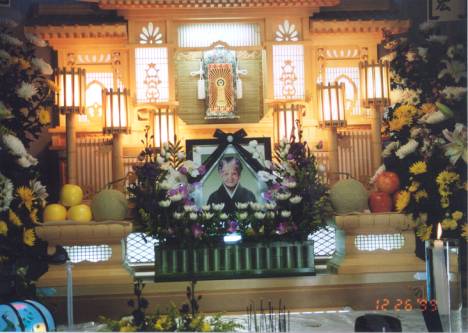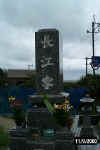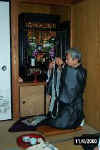

Shinto Funerals
 Shinto
is the indigenous religion of Japan. Being
primarily animistic, Shinto has no real founder or any written scriptures.
The Shinto religion has many temples, but people do not visit them like
Christians go to church. It is a
religion that is based on humans being good in nature.
Believers worship many deities such as Amaterasu, the Sun Goddess, who is
the ancestress of the Imperial Family. However,
since one's ancestors are highly revered, they too are worshipped.
Great care is taken when planning funerals and anniversaries of recent
deaths and in the upkeep of the gravesites and home shrines.
The photograph to the left is of a typical gravesite in Japan.
Even though it is large in size, only ashes are buried beneath it.
Usually fresh flowers are brought weekly.
A bowl of sand is used to hold the incense stick that is lit at the
beginning of each visit.
Shinto
is the indigenous religion of Japan. Being
primarily animistic, Shinto has no real founder or any written scriptures.
The Shinto religion has many temples, but people do not visit them like
Christians go to church. It is a
religion that is based on humans being good in nature.
Believers worship many deities such as Amaterasu, the Sun Goddess, who is
the ancestress of the Imperial Family. However,
since one's ancestors are highly revered, they too are worshipped.
Great care is taken when planning funerals and anniversaries of recent
deaths and in the upkeep of the gravesites and home shrines.
The photograph to the left is of a typical gravesite in Japan.
Even though it is large in size, only ashes are buried beneath it.
Usually fresh flowers are brought weekly.
A bowl of sand is used to hold the incense stick that is lit at the
beginning of each visit.
 Incense
is also lit before praying at the home shrines.
Normally there is at least one ancestorís picture hanging above the
shrine. Each morning, food and
drink are put at the shrine for an offering to their ancestors.
At this shrine, the red pedestal holds chocolate, one of their
ancestorís favorite foods. The
dishes and flower vases are cleaned daily.
These daily rituals are of the utmost importance; they are performed even
before breakfast is prepared.
Incense
is also lit before praying at the home shrines.
Normally there is at least one ancestorís picture hanging above the
shrine. Each morning, food and
drink are put at the shrine for an offering to their ancestors.
At this shrine, the red pedestal holds chocolate, one of their
ancestorís favorite foods. The
dishes and flower vases are cleaned daily.
These daily rituals are of the utmost importance; they are performed even
before breakfast is prepared.
 Preparation
is the key to Shinto ceremonies, including burials.
Each stage in a burial has to be precisely performed according to
centuries-old protocols. There are
over 20 procedures. Four of the
most interesting are: kichu-fuda,
koden, kotsuage, and bunkotsu. Kichu-fuda
is a period of intense mourning, which lasts for one day.
During this period, mourners wear solid black and some may carry a
rosary. A Shinto priest is needed
to perform the rituals to begin and end this day.
Here the priest is performing the rituals of chanting, singing, and
praying to begin the period of mourning. Because
the mourning period is only one day, several other steps take place during this
period, such as koden.
Preparation
is the key to Shinto ceremonies, including burials.
Each stage in a burial has to be precisely performed according to
centuries-old protocols. There are
over 20 procedures. Four of the
most interesting are: kichu-fuda,
koden, kotsuage, and bunkotsu. Kichu-fuda
is a period of intense mourning, which lasts for one day.
During this period, mourners wear solid black and some may carry a
rosary. A Shinto priest is needed
to perform the rituals to begin and end this day.
Here the priest is performing the rituals of chanting, singing, and
praying to begin the period of mourning. Because
the mourning period is only one day, several other steps take place during this
period, such as koden.
 Koden
is the giving of an obituary gift. Friends
and family of the deceased give monetary gifts to the family.
This helps to reduce the financial burden of the burial services. Here, these three men are accepting gifts on behalf of the
family.
Koden
is the giving of an obituary gift. Friends
and family of the deceased give monetary gifts to the family.
This helps to reduce the financial burden of the burial services. Here, these three men are accepting gifts on behalf of the
family.
Kotsuage is the gathering of a personís ashes. In the event that the bones do not burn completely, family members remove the bones with chopsticks and place them in the urn along with the ashes. This urn is then placed at the shrine for the services of the priest. Then it is removed and buried at the gravesite.
However, not all of the ashes are buried. During the bunkotsu stage, some ashes are given to close family members to put in the home shrines. One shrine, like the one above, may have the ashes of several ancestors. If the ashes are not passed down through the family, they will be returned to the grave.
Shintoism may be simple in nature, but it is very complex in terms of ceremonies. The customs leave no room for personalization. Everything has to be done a certain way at a certain time. Because they offer food and pray to their ancestors at least once a day, it is very hard to forget about them. Also, they hold anniversary ceremonies on the first, third, seventh, 13th, and 33rd years following someoneís death. It would be nice to know that one would be remembered so long after he or she had passed away. It is just not something that the American culture concentrates on.
1. Matsugo no mizu: when death is close, water will be given by cotton just to wet the lips and mouth, starting with the eldest relative.
2. Itai no tariatsu kai: wash body clean to ensure nothing dirty comes out of it; family members insert cotton into the nose, ears, and anus and force the mouth and eyes closed.
3. Kakejiku: hanging a painting of the deceased, never a photograph.
4. Kitamakura: use clean bedding, clasp the deceasedís hands together over his or her chest, and turn his or her head to the north.
5. Sakasagoto: inverting manners of daily life such as turning shoji screens (screens used as doors) upside down.
6. Shinishozoku: clothe the deceased in his or her favorite clothes; if female, makeup lightly; if male, shave.
7. Kichu-fuda: a period of intense mourning lasting 24 hours.
8. Mofuku: mourners dress in solid black with the exception of white dress shirt or white layer under kimono.
9. Juzu: mourners may hold a rosary, which is used for concentration.
10. Ihai: a mortuary tablet that is in the middle of the shrine at the funeral.
11. Shooko: an incense offering.
12. Koden: mourners give money to the immediate family to help take some of the burden of the funeral expenses off them.
13. Otsuya: the family gathers within 24 hours to discuss what the deceased would want for the future.
14. Tsuya: wake.
15. Kokorozuke: small gifts (not money) for the close friends that helped the family.
16. Kotsuage: when there are bones left from the cremation, a family member removes them from the ashes with chopsticks and passes them to another relative who also picks them up by chopsticks to place them in the urn.
17. Kiyome-shio: after the funeral, before entering the house, each person throws salt behind them to ward off evil spirits; some place a large amount of salt at the entrance of their houses and step on it before entering.
18. Koden-gaeshi: to acknowledge an obituary gift (12), a token, as well as a feeling of appreciation, is given.
19. Kiiake: for 49 days, the family cannot attend any parties or go to any happy places like amusement parks.
20. Kaimyo homyo: a posthumous name, for the deceased in Heaven (Tengoku), is given by the priest.
21. Matsuri: on the 3rd, 7th, and 49th days and the 1st, 3rd, 7th, 13th, and 33rd years after the death, the family goes to the grave site to light incense; a memorial service may also be held during those anniversary years.
22. Mochu hagaki: the mourning card that is sent after the 49th day to those who contributed.
23. Bunkotsu: if the family gives permission, some of the ashes may be given to close relatives to place in their home shrines; the rest of the ashes must be placed in an above ground mausoleum (ohaka).
www.religioustolerance.org/shinto.html
www.sekise.co.jp/sougi/eng/eng3.html
Interview with Yoshinobu Sato, translated by David McDowell.
Content Review Questions:
1) How is Shinto different from most organized religions?
2) How is Shinto similar to other religions?
3) Name three rituals required of the family of a newly deceased family member.
Content Review Answers:
1) There are no regular meetings or specific doctrines.
2) There is extensive ritual required of practitioners especially in the event of someone's death.
3) Any of the following or others: 24 hours of mourning, gifts to the family of the deceased, incense burned, flowers offered, regular remembrance of the deceased at the home alter and the family grave, use of the ashes of the deceased, . . .
Global Connections Questions:
1) How could Shinto, and the linking of the Emperor to the Japanese Sun Goddess Amaterasu, be exclusive of other global relationships?
Global Connections Answers:
1) Since the the Japanese Sun Goddess exclusive to cultures outside of Japan, it could in effect be considered exclusive of other global relationships and peoples.
Research Activities:
1) Compare the rituals prescribed by Japanese Buddhism (another interview
might be appropriate). What commonalities and distinctions are there? Create a
chart and present your findings.
2) Although Shinto is for the most part a collection of regional and local animistic religious practices, during the early twentieth century, the story of the imperial lineage being traceable to the Sun Goddess, Amaterasu became part of the national curriculum through the second world war. Find a more detailed account of this story linking the imperial line with the Sun Goddess and then respond to the following: How could a story like this become a means for the some Japanese to justify genocide and disregard for those who are of other ethnic and religious backgrounds?
3) Draw a world map and label the parts of the world that
follow local, animistic religious practices that have no set doctrines (include
parts of Africa, India, American Indian reservations, and others you can find.)
Create a chart that compares some of these peoples religious practices, ideally
for a specific event, like birth, death, or coming of age into maturity.
How have such local religious practices affected the interpretation and practice
of incoming world religions and how has the adoption of world religions affected
the practices of local religions. (For example, Shintoism and Hinduism
incorporated many of the practices and belief structures of Buddhism, while
local animistic beliefs in Central and South America affected the practices and
form of Catholicism brought by the new immigrants from Europe.